Write, Post, Unionize
by
Nicole Cohen,
Greig de Peuter
June 8, 2019
Featured in Logout! (#8)
Journalists and Self-Organization
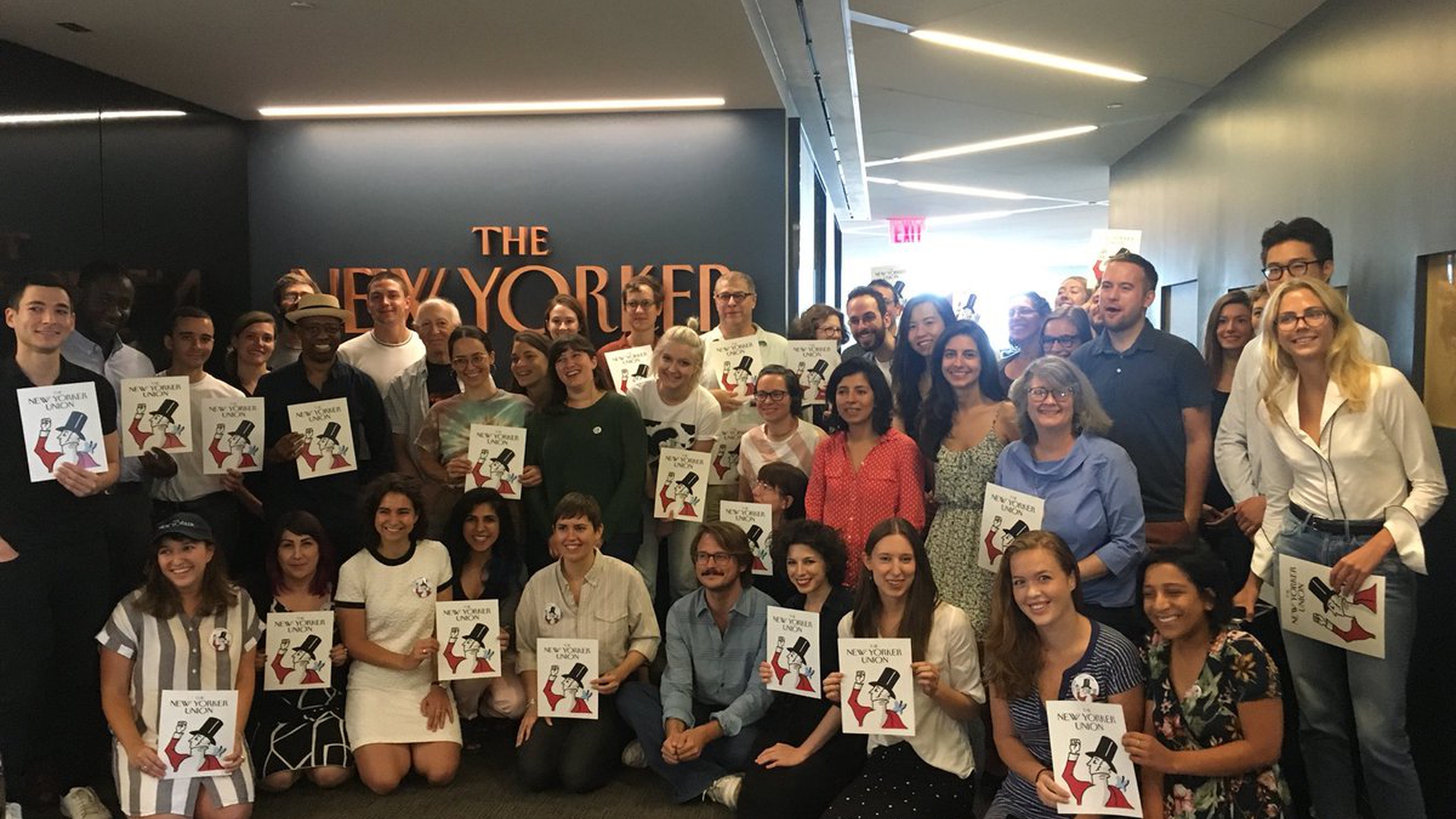
inquiry
Write, Post, Unionize
Journalists and Self-Organization
Since spring 2015, journalists in almost 50 newsrooms have unionized, mostly in digital-born outlets in the United States. This “wave” of unionization, as it has been dubbed in media accounts, took many by surprise. It defied the assumption that American millennials (who are the largest cohort in these digital media unions) are primed to dismiss unions as a relic of a fading industrial age.
The turn to unions also belied the popular image of digital-first media outlets like VICE and Vox: laid-back workplaces staffed by young, underpaid but happy writers, fueled by tech startups’ do-what-you-love, libertarian ethos, and housed in offices that look more like nightclubs than newsrooms. But journalists are unionizing in response to the new normal in digital media (and journalism more generally), including pressurized working conditions, precarious employment, and a lack of management transparency.
“These are white-collar workers,” says an editor we interviewed, “but they’re [unionizing] for the same reasons that anybody else would.” Motivations for organizing in each newsroom vary, but some grievances are common. Digital journalists work for low pay in expensive media cities, where many struggle to pay bills. Pay is wildly unequal, often contingent on one’s gender, race, or who offered them a job. Journalists view unionizing as a way to establish fairness and equity in pay and transparency around job structure and routes to promotion. They want job security for the legions of permalancers and contractors staffing digital media, and improved benefits such as healthcare, parental leave, and vacation.
Journalists are unionizing to gain protections in an industry in flux, where business models flip, advertising revenue is elusive, and layoffs are chronic. And while journalists accept the accelerated pace of work in digital newsrooms, they want to ensure overtime is recognized, regulated, and compensated. As one journalist puts it, he helped organize a union to ensure workloads are “more psychologically reasonable.”
Digital media drives extend beyond bread-and-butter issues. Journalists are organizing to address the lack of racial diversity in newsrooms—what one media worker describes as “the homogeneity of our industry”—to ensure people historically underrepresented in journalism are hired, promoted, and supported. And workers want greater control of their work: journalist-organizers increasingly view unionizing as a strategy to protect editorial independence from advertisers and political influence, ensure journalistic integrity, and promote editorial diversity.
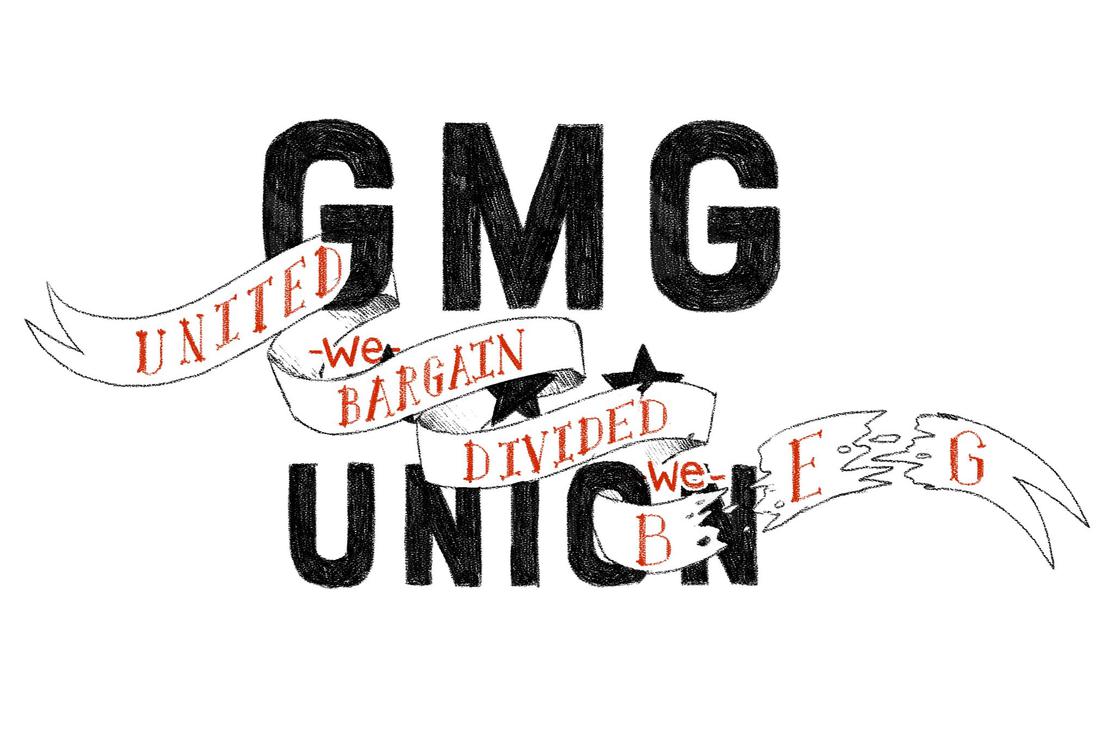
GMG Union illustration by Chelsea Beck (@beck2thefuture).
Over the last three years or so, around 2,000 media workers at digital outlets (VICE, Vox, Mic.com, Huffington Post, The Onion, Law360, and dozens of others) and legacy media alike (including The Los Angeles Times, The Chicago Tribune, The New Republic, and The New Yorker) have joined the Writers Guild of America, East (WGAE) and branches of the Communication Workers of America (CWA), primarily the NewsGuild. As digital media evolves, as journalist Seth Rosenthal puts it, “from a scrappy start-up where everyone does everything and there aren’t really rules or boundaries… to ‘now we’re a real corporation,’” journalists want to formalize working conditions, including establishing policies on salary, severance, equitable hiring, and editorial procedures. “They want to have power over their workplace and their careers,” says WGAE executive director Lowell Peterson. “It’s one thing to say, ‘I want the rules to be rational.’ They also want to help make the rules in the first place.”
As the labour movement continues to confront crisis and as worker-driven protests begin to rattle big tech, it’s vital to ask what, beyond grievances, is sustaining the organizing momentum in digital journalism and how might this energy be amplified? We’ve been researching why and how digital media workers organize. From our conversations—we’ve interviewed 44 journalists who organized unions in their newsrooms and union staff organizers—it’s clear that no two drives in this cycle of struggle are entirely alike. But what does stand out across almost all the drives is self-organization: journalists themselves are driving unionization. Journalists, a historically reluctant cohort to engage with organized labour, have initiated union campaigns, chosen a parent union to join, led card signing and recruitment, and set organizing priorities, sometimes challenging union doxa in the process.
Digital journalists’ self-organizing impulse was borne not from militant sensibilities or contempt for union bureaucrats, but from necessity. Unions were not clamoring to organize this sector. “There really wasn’t a large-scale commitment to organizing,” admits one union staffer. The NewsGuild had been focused on defending existing contracts as the newspaper industry was gutted. While the WGAE had its eye on digital media, particularly outlets like VICE, its first digital journalism shop was almost accidental: a WGAE organizer approached Gawker writer Hamilton Nolan to discuss VICE, and Nolan said, “why don’t you try to organize us?” The union was stunned when around 40 Gawker staff showed up to a rapidly scheduled first meeting, and even more surprised the day management voluntarily recognized the union. “I think that’s when it really began to dawn on us,” says former WGAE organizer Ursula Lawrence. “We received several calls and emails almost immediately from people at other publications.” Around the same time, journalists at the Guardian US and (the now-closed) Al-Jazeera America had contacted the NewsGuild of New York. These drives, paired with the buzz around Gawker’s campaign and the WGAE’s entry into digital journalism, fueled resolve in the NewsGuild to build a digital media strategy, and it received a $500,000 internal grant from its parent union, the CWA, to organize digital journalists.
A string of successful newsroom union drives generated momentum: watching newsroom after newsroom organize motivated many journalists to initiate their own campaigns. While journalists have tended to take the first step in assessing colleagues’ interest and contacting unions, the degree of self-organization shouldn’t be overstated. The mostly young journalists leading the drives generally had no prior experience organizing unions. They have needed guidance on tactics, laws, and procedures, and on matters such as composing inside committees and confronting management anti-unionism. “Most of us were so frustrated [with management]. We wanted to do the most drastic thing to get immediate results,” says a journalist who helped organize MTV News. “We really needed [the WGAE] to tell us how the process worked…to tell us the history of labour organizing, basically, and help us apply it to our situation.” A Thrillist organizer acknowledges that he and his co-workers “were very much novices going into this.” For him, unionizing was a “crash course in labour law and labour relations.”
Workers and union organizers involved in the drives we’ve studied speak positively about the mutual support between staff organizers and inside organizers, or those journalists who did the work of mobilizing their colleagues via one-on-one conversations, coordinating meetings, tracking support, and building solidarity in the workplace. Justin Molito, Director of Organizing at WGAE, describes his role as partly to push workers to go beyond their comfort zone to win recognition: “Even though people may be self-organized, they may not want to tweet at their boss, they may not want to think about what it’s going to be like to have an informational picket line or do a lunchtime work stoppage.” The pressure tactics journalists settled on to push intransigent management included all staff leaving their desks to eat lunch together (a rare occurrence) in their union T-shirts, and Slack strikes, or simultaneously exiting the internal chat program digital media workers are perpetually logged into. One journalist says that staff organizers “were good at presenting options and … letting us decide what would be most effective.”
A union organizer speaks of “decentralizing” the work of organizing, or developing an organizing model that’s “worker-driven” but “staff-facilitated.” While union organizers remain committed to core principles like having a robust and representative inside organizing committee, one-on-one conversations, strategic escalation, and building capacity to win a strong contract, some of the tactics they’ve used to get there have shifted. “Journalists have made us shift [tactics],” she says. For example, to track coworkers who supported or opposed unionizing, several inside committees used a Google document, which was helpful when working across multiple offices or with remote workers. Union staff were concerned that a digital list of union supporters could end up in employers’ hands, but journalists didn’t budge, and organizers ceded. Such flexibility has been “key to our success,” says the union organizer. “I’m not going to argue with a journalist… ‘You have to meet with me in person, then I’m going to give you a paper list, then you have to take it back.’ They’re going to be like, ‘Cool, I work in Chicago, I’m done with this organizing effort, it’s not going to work.’”
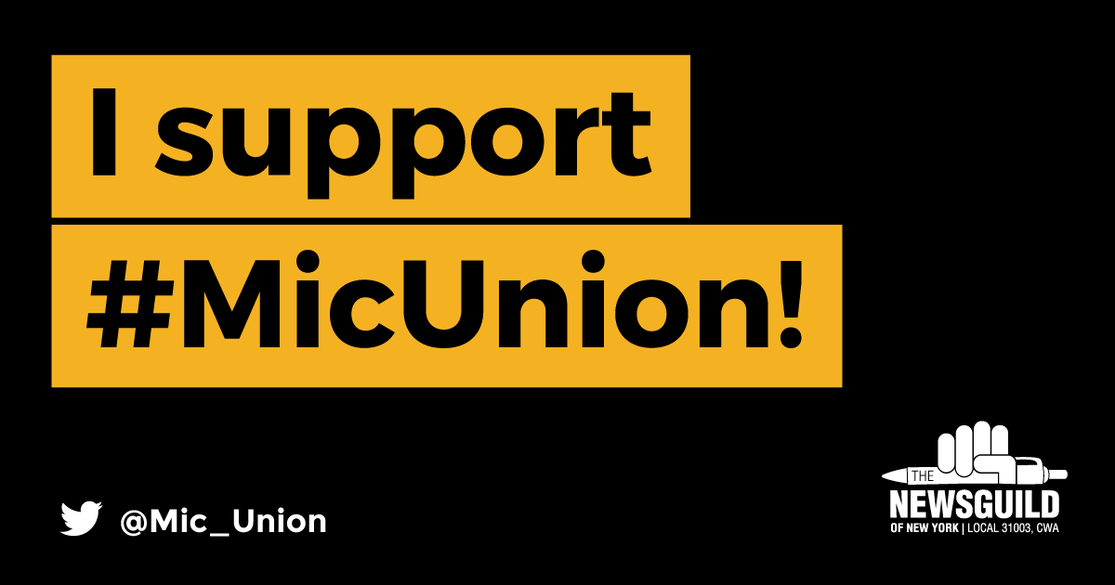
Graphic from the Mic union drive, shared by the NewsGuild of New York.
Nowhere has self-organization been more apparent than in the online communication practices of inside organizing committees and journalists involved in drives. In a typical union drive, staff organizers direct communication, generally preferring to keep a campaign clandestine until it’s time to go public, mindful of public perception and wary of management retaliation. But, as an organizer admits, “good luck telling 1,000 journalists that they’re not allowed to talk to their peers.” In most campaigns, journalist-organizers swiftly set up Twitter accounts, designed union logos, and orchestrated social media campaigns to push management to quickly voluntarily recognize the union. Unlike traditional union drives, several digital media drives have been exceptionally public: once a critical mass of workers have signed on, drives are publicly announced via statements with titles like “why we’ve decided to organize” and support is drummed up on social media. Even bargaining session results have been immediately tweeted and journalists have publicized how they are voting in elections.
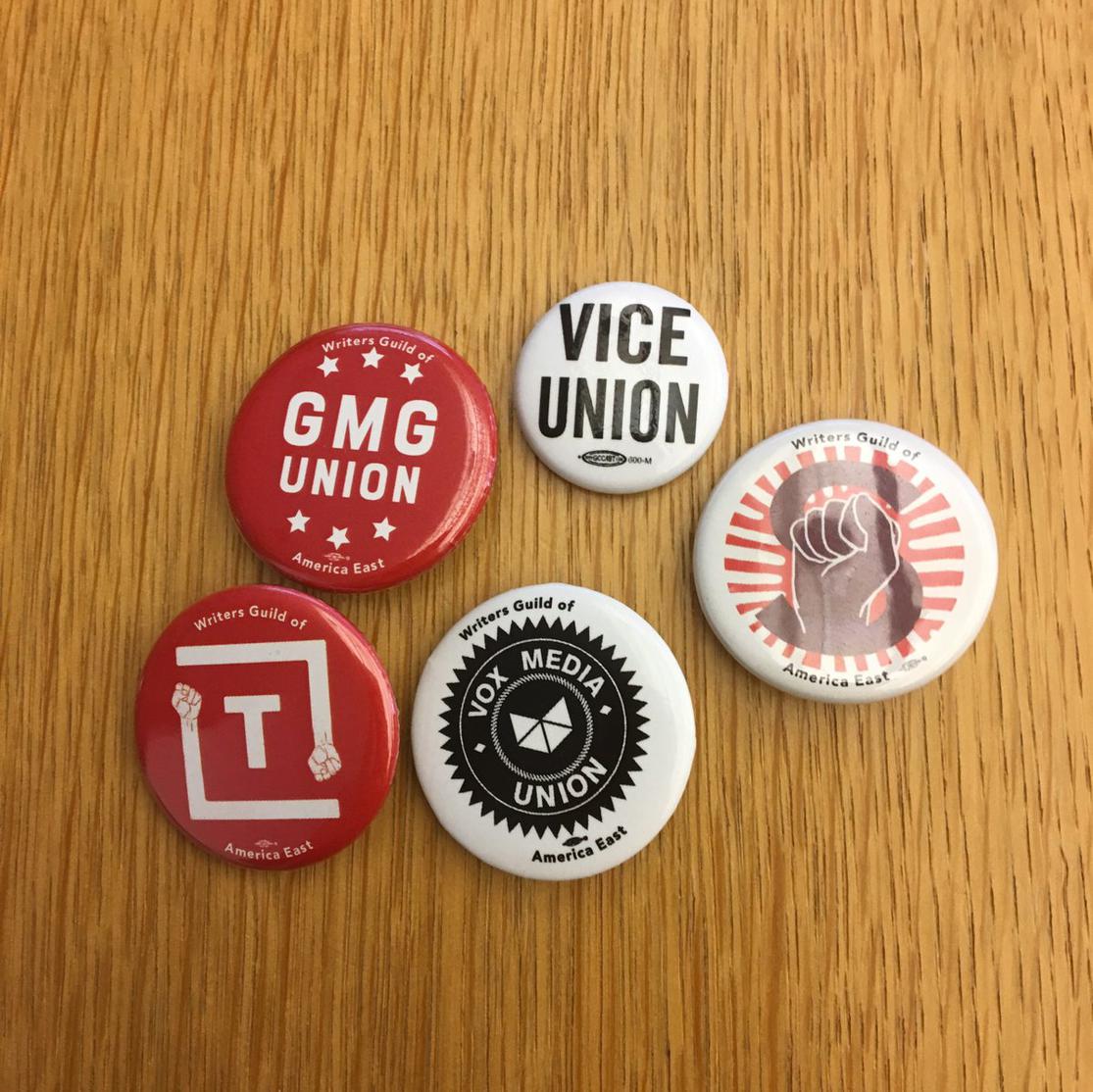
Digital media union buttons, photo by Eillie Anzilotti, member of the Fast Company Union bargaining committee
These communicative actions have been vital on two fronts. First is buy-in: doing campaign communications this way enables journalists to feel a sense of ownership over the union. Notably, digital media unions are not named as locals of parent unions, but for the places journalists work: VICE Union, L.A. Times Guild, Vox Media Union. Journalists tell us such naming strategies reflect pride in where they work, but such naming strategies have also strategically helped fend off a classic anti-union line: that a union is an outside third-party, parachuting in to impose terms and conditions. Many of the journalist-organizers we spoke to embrace the notion that “we are the union.”
Second, when journalists have had to fight hard for recognition, they’ve used social media to put public pressure on digital media executives’ desires to appear progressive to a massive global youth audience and the advertisers that want to reach them (unionizing journalists often link to pro-labour pieces their outlets published, for example). Social media outreach, says one journalist-organizer, is “intended to put the pressure on [management] and make sure that everybody’s watching to see what this company’s going to do and if it’s going to live up to the values that it preaches.” While some union staff were initially uneasy about ceding such control over communication to the journalists, a union organizer tells us that, in retrospect, “The benefits have outweighed the risks … visibility and people putting themselves out there is important to winning. It’s how we have won at these companies.
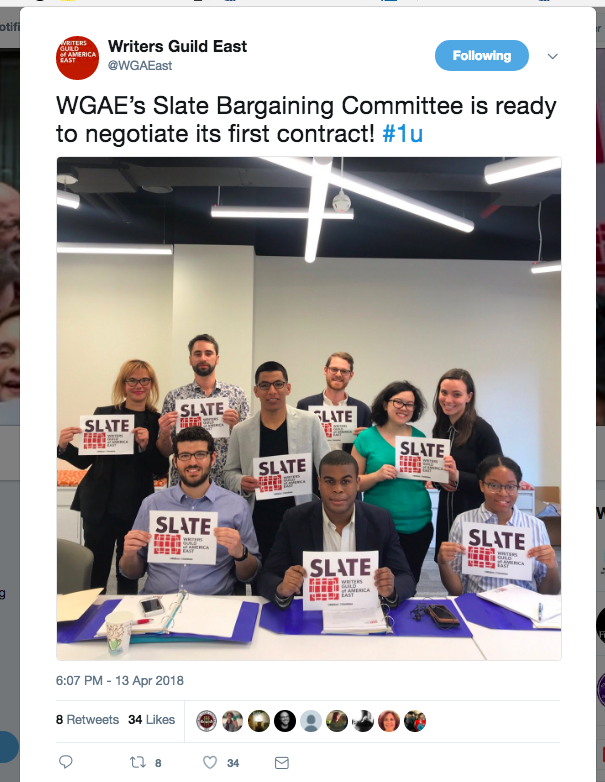
Slate’s bargaining committee, tweet by the Writers Guild of America, East, April 2018.
Journalists’ active engagement in union drives has been vital in embedding the expectation that the organization is member-driven and inclusive, which potentially leads to stronger unions. Adopting a we-are-the-union ethos also takes a preemptive strike against the tendency for unions to be perceived as mere service providers.
As digital outlets continue to unionize, parent unions are taking cues from the organizing membership. Recentering organizing is the single biggest impact, shaking unions from a “defensive posture,” as one NewsGuild organizer puts it. “For the union to really double down and put more resources into organizing now, and to have so many hot shops, where workers are coming to us…—it’s not something you experience very often as an organizer, as a union,” she says. Journalists’ organizing campaigns are influencing their parent unions’ contract priorities, too. “[W]e’re seeing more and more that these workers not only are coming to the table more interested in prioritizing (diversity and pay equity), but we as a union are prioritizing these issues, and figuring out the strongest possible language that we can start to introduce in our contracts.”
Digital journalists are keenly aware of journalism’s precarity, workers’ mobility, and companies’ tendencies to routinely announce layoffs or closures. Since winning a better deal from a current employer is not a long-term strategy for securing a livelihood in such a volatile business, journalist-organizers have recognized that unionization is not only about improving conditions at a single workplace, but about building solidarity and raising standards across their sector. From this perspective, “movement” is more apt than “wave” to describe the union push in digital media. Framing it as a movement also acknowledges the networks of solidarity that support these organizing campaigns. Journalists hold no illusions that unionizing is a panacea, but they recognize nonetheless that a union can be, in one media worker’s words, “a living and breathing mechanism to distribute power more evenly.”
Acknowledgments
We want to thank the journalists and organizers we interviewed for sharing their time, experience, and insights with us. This research is supported by the Social Sciences and Humanities Research Council of Canada.
Featured in Logout! (#8)
Subscribe to Notes from Below
Subscribe now to Notes from Below, and get our print issues sent to your front door three times a year. For every subscriber, we’re also able to print a load of free copies to hand out in workplaces, neighbourhoods, prisons and picket lines. Can you subscribe now and support us in spreading Marxist ideas in the workplace?
Read next
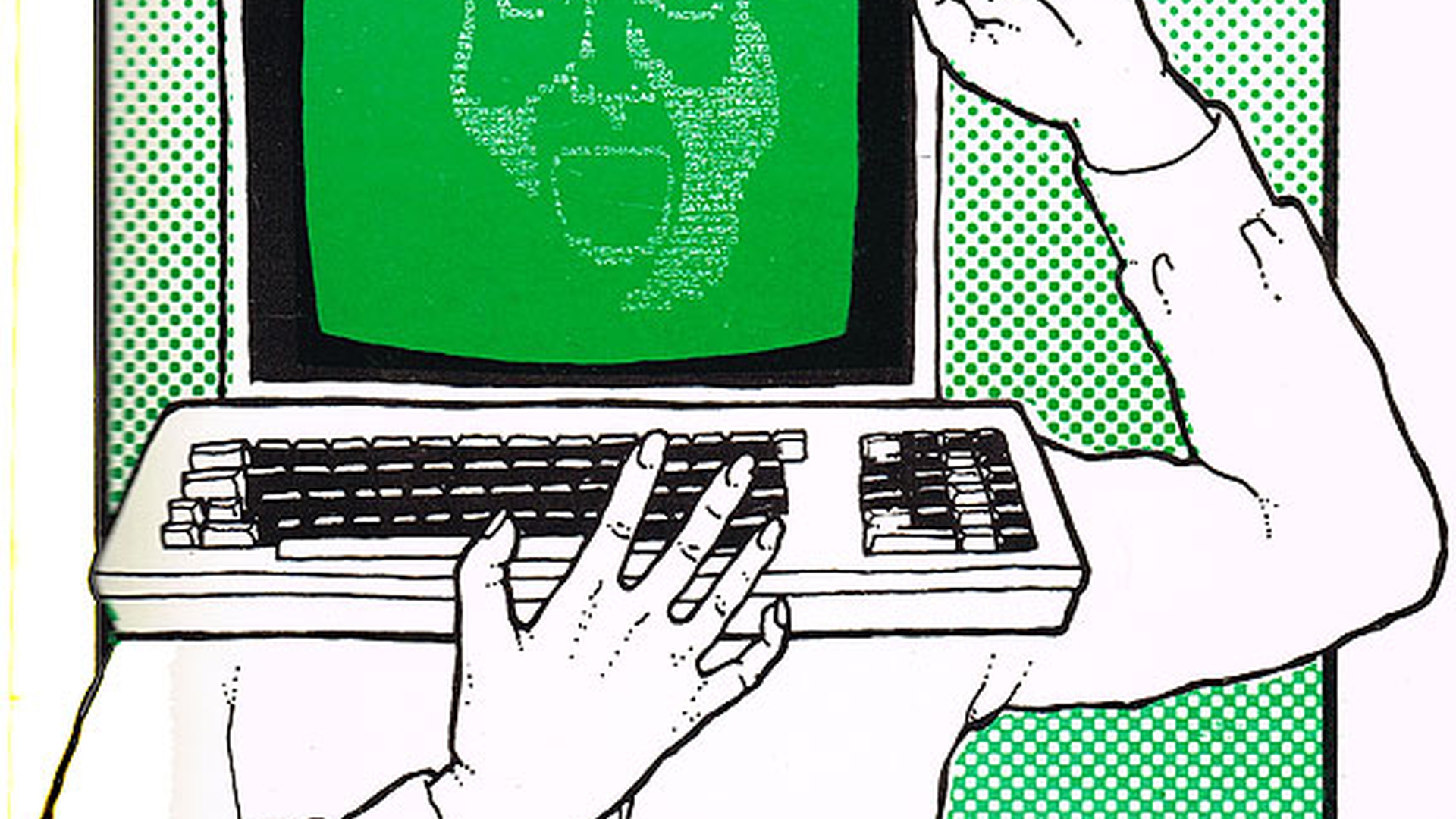
Processed World
by
Chris Carlsson
/
June 8, 2019

